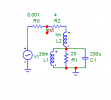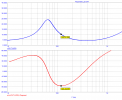Fascinating thread for this EE. However, the author's findings raise more questions than answers. First, as has been asked multiple times, how might an individual apply this finding to his own kit? Even if one has an impedance analyzer at home, the complex impedance of, say, a 3-way speaker will be all over the place compared to the trivially simple R//C combo that was tested here. I understand the author's position that this represents perhaps an extreme load, along the lines of certain e-stats, and so is more of a cautionary tale than an outright condemnation of this particular Class D amp.
But to me, the question this report really raises is - do we need to test Class D's under a variety of complex impedance loads to better determine if there are impedance combinations that result in in-band noise (hissing, etc.)? The only real complaints I've heard/read/experienced with Class D are two-fold: (1) high frequency hissing, and (2) ear fatigue. I suspect the latter may be related to the former, but there are other factors too ("dry sounding", etc., that have been described). Anyway, keeping it scientific - we might want to look more seriously into the behavior of Class D's using either (a) dummy complex impedance loads and/or (b) connection to actual speakers (PITA, perhaps more difficult to get high-precision results I suppose).
As a starting point, and I'm not an audio engineer so I don't know what's possible with test equipment - it would be informative to test this Class D amp's performance while connected to the most "problematic" e-stat speaker the ASR community is aware of.
One other comment I'll make, regarding oscillation and amplifiers. Traditional amplifiers (Class A, AB, etc.) are of course designed to have zero oscillations, either in-band or out-of-band. Oscillations in such amplifiers, even above audio range, are indicative of instability somewhere in the design. I'm an RF guy, so maybe my life has been different, but I can say with confidence that any traditional RF amp with any type of oscillation generally causes performance issues (in-band noise, IMD, etc.) and is stomped out by the designer. Most of the time it comes down to additional power supply filtering and/or careful input/output impedance matching. Class D is completely different. It's not a traditional amp at all. These amps are converting digital samples into analog waveforms, and actually require self-oscillating circuits that control sample rates. As such, and knowing that output feedback is a key element in controlling these oscillations, it should be no surprise to anyone that under varying loads - even with output feedback - we might see shifts in oscillation, and even aliasing of noise associated with the oscillation frequency(ies) back into the audio band. In the author's case, seems that's what happened - the severe capacitive load caused a shift in the amplifier's self-oscillation (or induced a secondary oscillation, i.e., subharmonic or outright additional oscillation) which folded noise back into the audio band. Any time a circuit has an unplanned/unknown resonance leading to oscillation, that nonlinear behavior almost always leads to some other consequence (noise, spurs, etc.). As others have noted, as long as it doesn't fold into the audio band, "who cares" should apply - but I would submit that any time one observes such shifting resonances, further investigation is definitely warranted. Back to the complex impedance test load thought... maybe it could help quantify these Class D audible artifacts that some have complained about. Maybe some class D's, for example, develop these in-band noise issues even with more modest complex loads. Feels like an entirely new measurement technique has potentially opened up because of this report.


